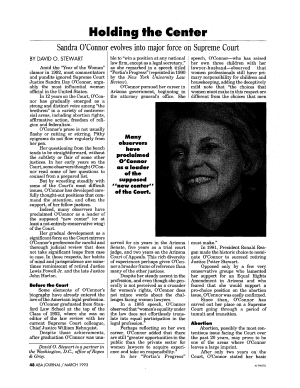Holding the Center
January 1993

DISCLAIMER: This text has been transcribed automatically and may contain substantial inaccuracies due to the limitations of automatic transcription technology. This transcript is intended only to make the content of this document more easily discoverable and searchable. If you would like to quote the exact text of this document in any piece of work or research, please view the original using the link above and gather your quote directly from the source. The Sandra Day O'Connor Institute does not warrant, represent, or guarantee in any way that the text below is accurate.
Article Text
(Excerpt, Automatically generated)
Holding the Center
Sandra O'Connor evolves into major force on Supreme Court
BY DAVID 0. STEWART
Amid the ''Year of the Woman" clamor in 1992, most commentators and pundits ignored Supreme Court Justice Sandra Day O'Connor, argu ably the most influential woman official in the United States.
In 12 years on the Court, O'Connor has gradually emerged as a strong and distinct voice among "the brethren" in a variety of controver sial areas, including abortion rights, affirmative action, freedom of reli gion and federalism.
O'Connor's prose is not usually flashy or cutting or stirring. Pithy epigrams do not flow regularly from her pen.
Her questioning from the bench tends to be straightforward, without the subtlety or flair of some other justices. In her early years on the Court, some observers thought O'Connor read some of her questions to counsel from a prepared list.
But by wrestling steadily with some of the Court's most difficult issues, O'Connor has developed care fully thought-out positions that com mand the attention, and often the support, of her fellow justices.
Indeed, many observers have proclaimed O'Connor as a leader of the supposed "new center" (or at least a not-entirely-conservative wing) of the Court.
Her gradual development as a significant force on the Court mirrors O'Connor's preference for careful and thorough judicial review that does not take significant leaps from case to case. In those respects, her habits of mind and jurisprudence are some times
